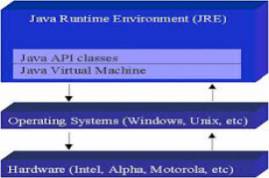Running multiple Java applications Java Runtime Environment (JRE) is a software layer that provides services for running Java applications. It is an essential part of the Java Development Kit (JDK) and contains all the tools necessary to run various Java-based applications. Since many web applications rely on the JRE to function, you need to install the latest version on your Windows device. Without it, you may have trouble sending games, chat boxes and movies. Java Runtime is not limited to Windows and is also available for download on the Mac. Is it a runtime environment? A runtime environment consists of a set of class files needed to run a program. It also provides the latter with access to memory and system resources, without which the application would not work. A few years ago, most software programs used the operating system of the device where it was loaded as an execution environment. They had the device’s memory, files and resources to run it (function () {(‘review-app-page-desktop’);}); However, with the creation of the Java Runtime Environment, Java applications no longer need to rely on the device’s operating system to run it. They can order resources, tools and JRE memory whenever needed. Due to the popularity of Javas, many applications, including games, web applications and services, are now required from the Java Runtime Environment to run smoothly. You can’t develop applications with JRE, but do you need it on your device to make Java work? Are you using the JRE? Some of the world’s leading companies, including Airbnb, Uber, LinkedIn and Spotify, use Java to create web and mobile apps. It is a relatively new programming language that is fast and secure and allows developers to create modular applications with recoverable code. However, the reason for its popularity lies in the fact that it is platform independent. This means that Java programs can be easily run on a wide variety of computers, as long as they have the Java Runtime Environment Java, developers can create a software application on one operating system and provide it to users running another system. For example, a Java application created on Windows will run smoothly on Mac or Linux computers. The only requirement is that all devices have the JRE installed. Due to the portability of the platform, Java is used to create billions of games, applications and services. Many medical devices, printers, navigation systems, cell phones and computers also use different functions: Java Runtime Environment is a meta-operating system on top of the computer’s operating system. It provides additional services specifically for applications written in Java. The main function of the Java virtual machine or JRE is to ensure that Java applications run on different operating systems without this being necessary. The JRE also consists of a series of components and libraries without which applications would not work. This includes automatic memory allocation and management, Java Web Start and Plug-in, Java Naming and Directory Interface (JNDI), Java Archive (JAR) and Java for XML Processing (JAX-WS), amongcustomizable configurations. The JRE has a control panel that allows you to configure security certificates and also network settings. You have access to all the features of the JRE and can change them according to your requirements. Does this include access to advanced features such as Java console, debugging, JavaFX runtime and standard Java a JRE file? A JRE file is the system file that contains all the class libraries and files needed to run Java code. Without it, you will not be able to run software programs written in Java. The latest version of the JRE includes performance improvements, enhancements, stability solutions and better security. Once installed, does the file ensure that all Java applications on the device work efficiently and can I install the Java Runtime Environment? After downloading the Java Runtime Environment, installation is quite simple. All you have to do is follow the instructions on the screen and the program will install itself. However, you need to activate the latest version to get it up and running. To do this, click on the Java tab available in the control panel. From here, make sure that the correct version of the JRE is enabled and save the updated Java Runtime Environment installed on my computer. To see if the JRE is installed on your computer, go to the Computer Control Panel and click the Programs button. . The device will display a list of all installed software programs. Make sure you have the Java Runtime Environment or Java Development Kit (JDK) installed on your computer. Since the JRE is part of the JDK, will most computers show only the latest Java programs that work without the JRE? When opening a Java application, the first thing to do is to ask the JRE to run it. Without your presence, the application will not work. Sometimes the JRE is not automatically updated with the latest versions available, so it is best to check the version on your computer. If you are looking for an alternative, you can consult JavaExe. You can also download the Java Development Kit if you want to develop the Java I upgrade to the latest version? If you are having trouble managing Java applications, you need to download and install the latest version of the Java Runtime Environment. The development tool consists of several class and resource libraries that require Java applications. It also knows and manages the memory needed by applications to make the application easier for users, not developers. You need to install it to run Java applications on your device. The latest version of the Java Runtime Environment offers improvements in performance, security and stability, along with some improvements.

